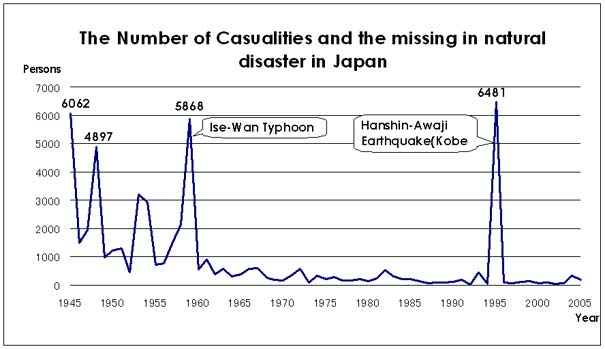
| ENGLISH |  |
BAHASA INDONESIA |  |
日本語 |
|
Outline of Japan's ODA Activity in Indonesia in Individual Sectors
Disaster Prevention
 Column for Experts: The History of the Development of Disaster Prevention in JAPAN Column for Experts: The History of the Development of Disaster Prevention in JAPANDid you know that until 40 years ago in Japan, several thousand people died each year due to natural disasters? The development of disaster prevention in recent years owes very much to the bitter experiences of having been victimized by natural disasters up until today. Question often asked by those concerned in disaster prevention in Indonesia is about the history of the disaster prevention in Japan. (Fig.4 The number of the victims of natural disasters in Japan)
The First Turnabout - The Ise Bay Typhoon and the Disaster Countermeasures Basic Law With this disaster as a turning point, the conventional disaster prevention system was criticized as being deficient, and in 1961, the Disaster Countermeasures Basic Law was enacted to develop a comprehensive and systematic disaster prevention order. The law contained three epoch-making features in proceeding with disaster prevention countermeasures.
The Second Turnabout - The Great Hanshin and Awaji Earthquake Learning from this, the Disaster Countermeasures Basic Law was revised in December 1995 as follows: In the case of a considerably extraordinary and severe disaster, the emergency disaster countermeasures headquarters headed by Prime Minister can be set up without a state of emergency declaration, the head of the emergency disaster countermeasures headquarters can direct the heads and similar of designated administrative organizations and that the items with regard to the conclusion of treaties in connection with reciprocal support between local public entities must be dealt hard to be realized. In the Great Hanshin and Awaji Earthquake about 80 percent of the victims died crashed under the fallen buildings and most of them died within 15 minutes after the earthquake. From these facts, people recognized anew the importance of the idea of “disaster prevention and mitigation” by “making buildings earthquake-proof.” Even today, countermeasures including seismic retrofitting of general households and public facilities, are underway as an urgent matter. Furthermore, in 2001 on the occasion of the reorganization of central government ministries and agencies, Disaster Prevention Bureau of National Land Agency which was in charge of the secretariat of the Central Disaster Prevention Council was moved to the Cabinet Office with the ministry in charge of disaster prevention posted permanently at the office. This helped in developing a system that made it possible to deal with a disaster at anytime while enabling the effort of disaster tackling to be executed constantly even when there is no disaster happening. Every year, Japan is hit by many typhoons as well as earthquakes. It is said that an earthquake of which the center is directly below the Tokyo metropolitan area or the Tokai earthquake or the East-Nankai and Nankai earthquakes or earthquakes around the Japan Trench and Chishima Trench can happen anytime. How can we be prepared for these? Right now, Japan is fighting against the clock to get ready for a disaster of gigantic scale. Human cannot prevent natural disasters such as typhoons and earthquakes from occurring. That’s why the challenge we face is how we can mitigate its damage when the natural disaster strikes. In the future, natural disasters can be even more severe due to the effects of the global warming. It is hoped that the Indonesian Government, just as the Japanese Government, will perceive the budget for disaster prevention to prevent disasters and mitigate the damage not as “expenditure” but as “investment” and continue to work hard in order to protect its people from natural disasters. |
|

 Return Top
Return Top

